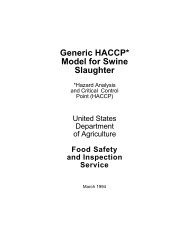Generic HACCP Model for Thermally Processed Commercial
Generic HACCP Model for Thermally Processed Commercial
Generic HACCP Model for Thermally Processed Commercial
Create successful ePaper yourself
Turn your PDF publications into a flip-book with our unique Google optimized e-Paper software.
CCP Determination Form<br />
The Critical Control Point (CCP) Determination <strong>for</strong>m is used to identify the critical<br />
control points in the process. A critical control point is defined as a point, step, or procedure at<br />
which control can be applied and a food safety hazard can be prevented, eliminated, or reduced<br />
to an acceptable level. All significant hazards identified in the hazard analysis must be addressed.<br />
Identification of each CCP can be facilitated by the use of a CCP Decision Tree (See Attachment<br />
2). The Decision Tree asks a series of four, yes or no, questions to assist in determining if a<br />
particular step is a CCP <strong>for</strong> a previously identified hazard. These four questions are listed at the<br />
top of the CCP Determination <strong>for</strong>m. Use this as a guide when determining if an identified<br />
significant hazard is a critical control point. CCP's must be carefully developed and<br />
documented and must be <strong>for</strong> product safety only. Different facilities preparing the same<br />
food can differ in the risk of hazards and the points, steps, or procedures which are CCP's.<br />
This can be due to differences in each facility such as layout, equipment, selection of ingredients,<br />
or the process that is employed.<br />
In this document the CCP's that are identified are <strong>for</strong> illustrative purposes only. Your<br />
individual process will determine the CCP's identified. Remember that proper Sanitary Operating<br />
Procedures and maintenance programs are essential prerequisites to <strong>HACCP</strong>.<br />
22



